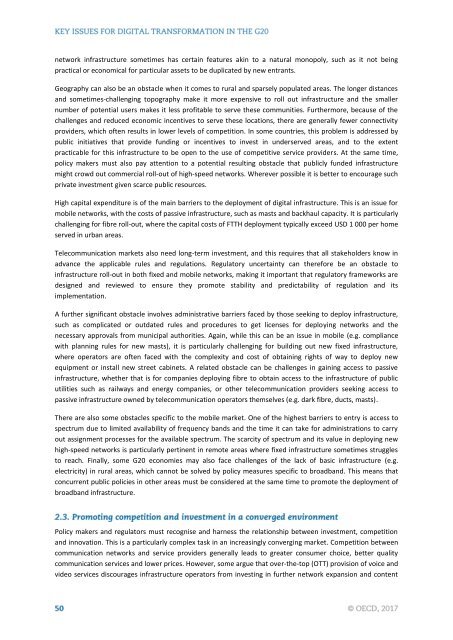KEY ISSUES FOR DIGITAL TRANSFORMATION IN THE G20
2jz0oUm
2jz0oUm
Create successful ePaper yourself
Turn your PDF publications into a flip-book with our unique Google optimized e-Paper software.
network infrastructure sometimes has certain features akin to a natural monopoly, such as it not being<br />
practical or economical for particular assets to be duplicated by new entrants.<br />
Geography can also be an obstacle when it comes to rural and sparsely populated areas. The longer distances<br />
and sometimes-challenging topography make it more expensive to roll out infrastructure and the smaller<br />
number of potential users makes it less profitable to serve these communities. Furthermore, because of the<br />
challenges and reduced economic incentives to serve these locations, there are generally fewer connectivity<br />
providers, which often results in lower levels of competition. In some countries, this problem is addressed by<br />
public initiatives that provide funding or incentives to invest in underserved areas, and to the extent<br />
practicable for this infrastructure to be open to the use of competitive service providers. At the same time,<br />
policy makers must also pay attention to a potential resulting obstacle that publicly funded infrastructure<br />
might crowd out commercial roll-out of high-speed networks. Wherever possible it is better to encourage such<br />
private investment given scarce public resources.<br />
High capital expenditure is of the main barriers to the deployment of digital infrastructure. This is an issue for<br />
mobile networks, with the costs of passive infrastructure, such as masts and backhaul capacity. It is particularly<br />
challenging for fibre roll-out, where the capital costs of FTTH deployment typically exceed USD 1 000 per home<br />
served in urban areas.<br />
Telecommunication markets also need long-term investment, and this requires that all stakeholders know in<br />
advance the applicable rules and regulations. Regulatory uncertainty can therefore be an obstacle to<br />
infrastructure roll-out in both fixed and mobile networks, making it important that regulatory frameworks are<br />
designed and reviewed to ensure they promote stability and predictability of regulation and its<br />
implementation.<br />
A further significant obstacle involves administrative barriers faced by those seeking to deploy infrastructure,<br />
such as complicated or outdated rules and procedures to get licenses for deploying networks and the<br />
necessary approvals from municipal authorities. Again, while this can be an issue in mobile (e.g. compliance<br />
with planning rules for new masts), it is particularly challenging for building out new fixed infrastructure,<br />
where operators are often faced with the complexity and cost of obtaining rights of way to deploy new<br />
equipment or install new street cabinets. A related obstacle can be challenges in gaining access to passive<br />
infrastructure, whether that is for companies deploying fibre to obtain access to the infrastructure of public<br />
utilities such as railways and energy companies, or other telecommunication providers seeking access to<br />
passive infrastructure owned by telecommunication operators themselves (e.g. dark fibre, ducts, masts).<br />
There are also some obstacles specific to the mobile market. One of the highest barriers to entry is access to<br />
spectrum due to limited availability of frequency bands and the time it can take for administrations to carry<br />
out assignment processes for the available spectrum. The scarcity of spectrum and its value in deploying new<br />
high-speed networks is particularly pertinent in remote areas where fixed infrastructure sometimes struggles<br />
to reach. Finally, some <strong>G20</strong> economies may also face challenges of the lack of basic infrastructure (e.g.<br />
electricity) in rural areas, which cannot be solved by policy measures specific to broadband. This means that<br />
concurrent public policies in other areas must be considered at the same time to promote the deployment of<br />
broadband infrastructure.<br />
Policy makers and regulators must recognise and harness the relationship between investment, competition<br />
and innovation. This is a particularly complex task in an increasingly converging market. Competition between<br />
communication networks and service providers generally leads to greater consumer choice, better quality<br />
communication services and lower prices. However, some argue that over-the-top (OTT) provision of voice and<br />
video services discourages infrastructure operators from investing in further network expansion and content


